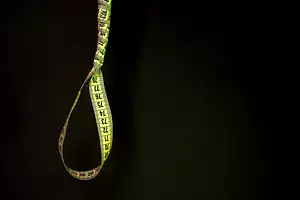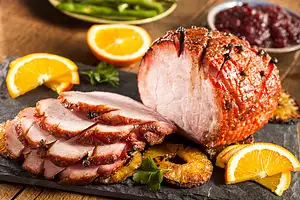Are you planning to celebrate Easter this year with a special meal? Will your Easter feast center around a traditional main dish, such as glazed ham, crown roast, or roast leg of lamb? Keep reading to find tips for preparing each of these classic Easter main dishes, recipes to try, and ideas for using up leftovers.
Why have glazed ham, crown roast, and roast leg of lamb become classic Easter main dishes?
In the United States, ham is a popular dish to serve on Easter. In the early days of the United States, pigs were often slaughtered in the autumn and the cuts of meat were then cured. The first hams were fully cured and ready to eat in the Spring, around Easter, so many families took advantage of this readily available meat.
Lamb has a long history of being eaten at Easter. Those of Jewish faith celebrate Passover by eating roasted lamb. As some of the Jewish faith converted to Christianity, they brought their tradition of eating lamb to their celebration of Easter. In many parts of the world, lamb is more readily available and affordable than other types of meat, making it a popular choice for many Easter celebrations.
Tips for Preparing Your Classic Main Dish for Easter
Glazed Ham
When selecting a ham for your Easter meal, remember bone-in hams have more flavor than boneless, while boneless hams are easier to carve than bone-in. As you think about the flavors you will be adding to your ham as you bake and glaze it, remember ham curing recipes usually include salt, spices, and sugar. Hams are often smoked after they are cured and have a smoky flavor.
Keep in mind that hams must be cooked to package directions to avoid food poisoning. However, most hams available in grocery stores have been adequately cooked to kill trichinosis and only need to be heated through in the oven. To prepare uncooked ham, plan on baking for 20 minutes per pound at 350 degrees F. To prepare a precooked ham, plan on baking for 10 minutes per pound at 350 degrees F to heat through.
To properly carve your ham, begin by letting it rest for about 15 minutes after baking, so that the juices can redistribute and it will be easier to handle. Using a meat fork and carving knife, with the shank on the right, carve 2-3 slices off of the ham to make a base. Turn the ham so it is resting on this base. Use the meat fork to stabilize the ham while you cut down to the bone with the knife. Then, run the knife along the bone. Remove the portion of meat you have just detached from the ham to a cutting board and slice.
Do you need ideas for using up leftover ham? Try using it in sandwiches, omelettes, potato casseroles, as a topping for baked potatoes, or cut it into bite-sized chunks and fold it into pasta dishes or your favorite hash recipe.
Crown Roast Tips
Crown roast is made by tying two racks of pork or lamb ribs back-to-back in a circle. Plan to serve one rib of pork crown roast or two ribs of lamb crown roast per person. When you purchase you crown roast, ask the butcher to french your crown roast and crack the chine bone between each rib so it will be easy to carve.
There is not a lot of meat on each lamb rib, so think about stuffing or filling the crown roast with rice, orzo, bread stuffing, cooked vegetables, or cooked potatoes.
To prepare your crown roast for baking, begin by tying securely with butcher’s twine. Cover the ends of the rib bones with aluminum foil. Before baking, fill the crown roast with uncooked bread stuffing or fill it after baking with cooked rice, orzo, veggies, potatoes, or sweet potatoes. To carve the crown roast, simply slice it between each rib.
Roast Leg of Lamb Tips
As you select lamb for your roast leg of lamb, remember if you are purchasing younger lamb, look for bright pink flesh, pink bones, and white fat. If you will be preparing older lamb, look for dark red meat and bones. Keep in mind that the most tender roast of lamb always comes from the leg. Plan for 1 lb. of bone-in roast per person or ½ lb. per person of boneless roast.
Before baking, insert a meat thermometer into the roast, but do not let it rest on the bone. Cook your roast leg of lamb to your desired doneness. Your roast will be medium-rare when it reaches 145 degrees F and well-done when it reaches 165 degrees F. Let the roast rest covered with foil, 15 minutes before carving.
To carve your roast leg of lamb, use a meat fork to anchor the roast and a carving knife to cut. Have the shank on the right. Cut ¼ inch slices down to the bone. Hold these slices with meat fork and run knife horizontally along the bone to release them.
Use leftover roasted lamb as a filling in shepherd’s pie, pita, or sandwich or folded into a recipe of moussaka, rice or orzo dishes, casseroles, or stew.
Recipes
Glazed Ham
Pineapple Brown Sugar Glazed Ham
Crown Roast
Ancho Chili Scented Crown Roast of Pork
Savory Apple Stuffed Pork Crown Roast
Crown Roast of Lamb with Tipsy Sweet Potato Stuffing
Roast Leg of Lamb
Roast Leg of Lamb with Pomegranate
Herb Roasted Leg of Lamb with Roast Onions
Roast Leg of Lamb with Rhubarb Mint Chutney
Arni Lemonato (Roast Lemon Lamb)
Glazed Roast Lamb with Rhubarb Salsa
Shepherd’s Roast with Drunken Sauce
Sources:
Marion Cunningham, The Fannie Farmer Cookbook. New York: Bantam Books, 1994. Print.









Comments